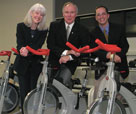Exercise Science Department marks a coming of age

Trying out the wheels in the new facility are three graduates of Exercise Science, formerly known as Bio-Physical Education: Dr. Ann-Merie O’Halloran is Manager, Clozaril Support & Assistance Network, Novartis Pharmaceuticals Canada. Dr. Robert Kilgour is the current department chair, and Dr. James Mansi is Associate Director, Scientific Affairs, Merck Frosst Canada, Vaccine Division.
Photo by Andrew Dobrowolskyj
The Department of Exercise Science’s 30th anniversary finds the school on the brink of big changes.
Boasting new facilities and a new commitment to research, today’s Exercise Science bears scant resemblance to that of three decades ago. In the words of Professor Robert Kilgour, chair of the department, “These are very exciting times.”
Anticipating attrition due to retirement, the department hired seven new faculty members between 1999 and 2002. They courted candidates with strong fundamental science backgrounds and track records of high research productivity — a marked departure from the school’s focus of old.
“When I was hired on 20 years ago,” Kilgour recalls, “this program was very much a teaching program. We taught students to be exercise scientists, whatever that meant back then.”
Kilgour was part of a new wave of exercise scientists who looked beyond the classroom by pursuing research interests, but such endeavours were the exception to the rule.
The dearth of research activity wasn’t for a lack of effort. In trying to carve its niche somewhere between medicine and fundamental science, the discipline wasn’t fully embraced by either, nor was it understood by the people controlling the all-important research funding pursestrings.
A lot has changed since then. The new faculty members’ interdisciplinary backgrounds make for increased co-operation between Exercise Science and other disciplines. This not only positively impacts funding, it influences the kinds of research being done.
The Exercise Science Department of 1980 concerned itself with topics such as investigating the pros and cons of a three-day-a-week exercise regimen; the department of 2003, however, may explore blood flow in certain muscles (using exercise as a modality, a means to an end), or the effectiveness of a pre-surgery exercise program to speed patient recovery.
This new direction in exercise science research was evident at a symposium held in the department on Sept. 29, where faculty member Dr. Robert Boushel hosted two of his frequent collaborators. Dr. José A.L. Calbet (Spain) spoke on maximal vascular conductance during exercise in humans, and Dr. Benjamin Miller (Denmark) discussed muscle and collagen protein synthesis in response to strenuous exercise.
The department’s new home in the Richard J. Renaud Science Complex plays a crucial role in facilitating this trend. The new space doubles the department’s previous area, and the sparkling new research facilities will allow faculty to do the kind of research that just wasn’t possible in their old, cramped environs.
Kilgour hopes that being close to the fundamental science departments will help nurture the growing trend toward interdepartmental collaboration. He just returned to the department after serving as both Vice-Dean of Faculty Curriculum & Approval and Vice-Dean of Student Affairs. With new facilities and a dynamic faculty, he says he’s thrilled to be back.